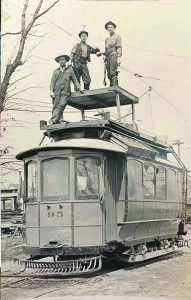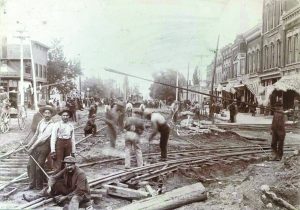Trolley Express reflects villages’ history
By Joseph Goral
Staff Writer
jgoral@mihomepaper.com
OXFORD TWP. — More than a century before Oxford and Lake Orion’s downtown trolley express began shuttling people between the two villages, Detroit had more interurban rail miles than any other city in the country. Riders could not only a trolley by rail between Oxford and Lake Orion, but use the same line to travel to Flint, Rochester, Royal Oak and Detroit.
The line to Lake Orion was completed on June 10, 1900, while the first car in Oxford arrived in front of a large crowd at the Oakland Hotel 12 days later, located where Washington Square is presently located, according to the Northeast Oakland Historical Museum. Among the passengers were Detroit United Railway (DUR) executives, Oxford council members and local businessmen.
These executives, council members and businessmen were some of the first to experience the trolley cars’  amenities, which Drew Holt of the Northeast Oakland Historical Museum said could be luxurious with their carved ornate paneling, brass lavatory fixtures and deep and comfortable seats in the smoking section. Men could enjoy the seats that is – women were not allowed to use them as the smoking section was for men only.
amenities, which Drew Holt of the Northeast Oakland Historical Museum said could be luxurious with their carved ornate paneling, brass lavatory fixtures and deep and comfortable seats in the smoking section. Men could enjoy the seats that is – women were not allowed to use them as the smoking section was for men only.
Trolley parties quickly became a popular form of entertainment, according to the Oxford Leader’s July 27, 1900 issue. One of the largest involved 24 people led by Homer Warren of Detroit. The party was catered and included a stop in Lake Orion where guests “took a boat ride and viewed the scenes and sights around the assembly.”
The group had a half-hour layover in Oxford and were “much pleased with the picturesque route between [Oxford] and Rochester.”
At least one party arrived in Oxford every week by July 27, 1900, according to the volume three issue.
Passengers paid an average of a penny per-mile, and could ride from Oxford to Detroit for 50 cents. The ride was powered by electricity from overhead lines. An arm, called a trolley, ran from the line to the car to conduct electricity to the motor. Holt said this is where the term “trolley car” comes from.
This power allowed trolleys to reach speeds of 40 to 50 miles per hour. At that pace, a rider from Detroit looking to enjoy the Oakland Hotel’s famous steak dinner could make the trip in 90 minutes.
Over 357 million passengers rode DUR lines in 1923 – creating bursts in development at rates not seen when people needed to find a horse and buggy to travel to Lake Orion and Oxford after arriving in Pontiac by train, according to Holt.
“When the DUR came laying tracks, they just brought so much more commerce too,” Holt said. “[My grandmother] and her mother would take the train down to Detroit, where otherwise, if you don’t have an automobile that’s a long walk.
“Mass transportation changes everything as far as the development and the progression of towns and cities becoming bigger and bigger.”
 The tracks ran near, and at times under, much of the development Oxford and Lake Orion residents are familiar with today.
The tracks ran near, and at times under, much of the development Oxford and Lake Orion residents are familiar with today.
After arriving in Rochester, the track ran parallel to Orion Road on its way to Lake Orion – entering the village around where Jacobsen’s Flowers is located today. Trolleys then traveled north to Oxford, which had a turn-around track at the corner of Washington Street and West Burdick Street, according to the Northeast Oakland Historical Museum. The tracks were later extended north, then turned east on East Street, north on Louck Street, then went west to cross Washington Street before making its way to Flint.
As hundreds of millions of riders traveled the DUR’s lines in 1923, Ford’s assembly lines were producing millions of Model Ts. Its affordability and popularity marked the beginning of the end for the railway. By 1930, most lines no longer operated, according to Holt. Detroit being the motor city meant less focus on trains and no subway system downtown.
“But also, [the rail system] actually expanded really fast,” Holt said. “It was a new technology with direct current, and so they expanded faster than they could keep up with.”
The trolleys being quiet also led to many lawsuits as people were struck by them while crossing the road, according to Holt, who said the lines existed before road crossings and safety gates were common place at rail roads. These types of accidents occurred often and were especially common in Oxford.
 A man driving his truck was killed and passengers were thrown from their seats in October 17, 1929 when the man “drove his truck into the north bound interurban” near Oakwood Road two-and-a-half miles north west of the village, according to that week’s issue of the Oxford Leader.
A man driving his truck was killed and passengers were thrown from their seats in October 17, 1929 when the man “drove his truck into the north bound interurban” near Oakwood Road two-and-a-half miles north west of the village, according to that week’s issue of the Oxford Leader.
A combination of the model T’s popularity, quick expansion and accidents all contributed to the railway’s decline in popularity. Although the trains stayed in Oxford for some time after, the DUR “kind of went away around those mid-1950s.”
Oxford’s depot was demolished in 1956, the same year president Eisenhower signed the Federal-Highway-Aid act that would change the face of America, according to the US Department of Transportation.
Today, in a car-centric country, and in Michigan, home of the motor city, Oxford and Lake Orion’s downtown trolley echoes an era when mass transit connected the villages.

Leave a Reply